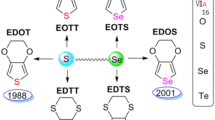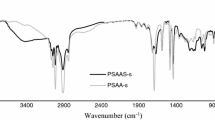Abstract
The development of proton conducting membranes based on poly(styrene sulfonic acid-co-1-vinylimidazole-co-styrene) (PSSA-co-PVIm-co-PS)/poly(vinyl chloride) (PVC) blends is firstly reported. PSSA-co-PVIm-co-PS with three different terpolymer compositions were synthesized via conventional free radical polymerization by varying styrene feed. Successful syntheses were confirmed by 1H-nuclear magnetic resonance spectroscopy (1H-NMR), elemental analysis, and Fourier transform infrared spectroscopy (FTIR). Hydrolytically stable PSSA-co-PVIm-co-PS/PVC blend membranes were prepared via solution-cast method. Scanning electron microscopy (SEM) images along with two glass transition temperatures observed from differential scanning calorimetry (DSC) suggested immiscible polymer blends. Water uptake and ion exchange capacity (IEC) were found to decrease with increasing PS content in terpolymer. All blend membranes had high thermal decomposition onsets of 230 °C. The blends demonstrated high storage moduli at room temperature and high oxidative stability. Proton conductivity at 25 °C of membranes equilibrated with water vapor was found to depend on PS content, and a maximum conductivity of 7.8 × 10−5 S/cm was achieved from 1:1:4/PVC blend membrane. For dry membranes, the effect of PS amount on proton conduction was not clearly observed at elevated temperatures (100–120 °C).










Similar content being viewed by others
References
Pei P, Chen H (2014) Main factors affecting the lifetime of proton exchange membrane fuel cells in vehicle applications: a review. Appl Energ 125:60–75. https://doi.org/10.1016/j.apenergy.2014.03.048
Vinothkannan M, Kannan R, Kim AR, Kumar GG, Nahm KS, Yoo DJ (2016) Facile enhancement in proton conductivity of sulfonated poly (ether ether ketone) using functionalized graphene oxide—synthesis, characterization, and application towards proton exchange membrane fuel cells. Colloid Polym Sci 294(7):1197–1207. https://doi.org/10.1007/s00396-016-3877-8
Kim AR, Vinothkannan M, Yoo DJ (2017) Sulfonated-fluorinated copolymer blending membranes containing SPEEK for use as the electrolyte in polymer electrolyte fuel cells (PEFC). Int J Hydrogen Energy 42(7):4349–4365. https://doi.org/10.1016/j.ijhydene.2016.11.161
Sahu AK, Ketpang K, Shanmugam S, Kwon O, Lee S, Kim H (2016) Sulfonated graphene-nafion composite membranes for polymer electrolyte fuel cells operating under reduced relative humidity. J Phys Chem C 120(29):15855–15866. https://doi.org/10.1021/acs.jpcc.5b11674
Whittingham MS, Savinell RF, Zawodzinski T (2004) Introduction: batteries and fuel cells. Chem Rev 104(10):4243–4244. https://doi.org/10.1021/cr020705e
Hickner MA, Ghassemi H, Kim YS, Einsla BR, McGrath JE (2004) Alternative polymer systems for proton exchange membranes (PEMs). Chem Rev 104(10):4587–4611. https://doi.org/10.1021/cr020711a
Bozkurt A, Meyer WH, Wegner G (2003) PAA/imidazol-based proton conducting polymer electrolytes. J Power Sources 123(2):126–131. https://doi.org/10.1016/S0378-7753(03)00560-3
Çelik SU, Bozkurt A (2011) Proton conduction promoted by 1H-1,2,3-benzotriazole in non-humidified polymer membranes. Electrochim Acta 56(17):5961–5965. https://doi.org/10.1016/j.electacta.2011.04.108
Yamada M, Honma I (2005) Anhydrous proton conducting polymer electrolytes based on poly(vinylphosphonic acid)-heterocycle composite material. Polymer 46(9):2986–2992. https://doi.org/10.1016/j.polymer.2005.02.056
Göktepe F, Bozkurt A, Günday ŞT (2008) Synthesis and proton conductivity of poly(styrene sulfonic acid)/heterocycle-based membranes. Polym Int 57(1):133–138. https://doi.org/10.1002/pi.2335
Kreuer KD (1998) New proton conducting polymers for fuel cell applications. Solid state ionics: science and technology. World Science, Singapore
Martwiset S, Chaisaward K, Treepetc S, Tayraukhamc P (2017) Proton conducting membranes based on poly(acrylonitrile-co-styrene sulfonic acid) and imidazole. Int J Hydrogen Energy 42(10):6918–6925. https://doi.org/10.1016/j.ijhydene.2017.02.130
Ko T, Kim K, Lim MY, Nam SY, Kim TH, Kim SK, Lee JC (2015) Sulfonated poly(arylene ether sulfone) composite membranes having poly(2,5-benzimidazole)-grafted graphene oxide for fuel cell applications. J Mater Chem A 3(41):20595–20606. https://doi.org/10.1039/c5ta04849d
Acar O, Sen U, Bozkurt A, Ata A (2009) Proton conducting membranes based on poly(2,5-benzimidazole) (ABPBI)-poly(vinylphosphonic acid) blends for fuel cells. Int J Hydrogen Energy 34(6):2724–2730. https://doi.org/10.1016/j.ijhydene.2009.01.073
Acar O, Sen U, Bozkurt A, Ata A (2010) Blend membranes from poly(2,5-benzimidazole) and poly(styrene sulfonic acid) as proton-conducting polymer electrolytes for fuel cells. J Mater Sci 45(4):993–998. https://doi.org/10.1007/s10853-009-4030-6
Ye YS, Chen WY, Huang YJ, Cheng MY, Yen YC, Cheng CC, Chang FC (2010) Preparation and characterization of high-durability zwitterionic crosslinked proton exchange membranes. J Membr Sci 362(1–2):29–37. https://doi.org/10.1016/j.memsci.2010.06.004
Li HQ, Liu XJ, Xu J, Xu D, Ni H, Wang S, Wang Z (2016) Enhanced proton conductivity of sulfonated poly(arylene ether ketone sulfone) for fuel cells by grafting triazole groups onto polymer chains. J Membr Sci 509:173–181. https://doi.org/10.1016/j.memsci.2016.02.039
Arunbabu D, Sanga Z, Seenimeera KM, Jana T (2009) Emulsion copolymerization of styrene and sodium styrene sulfonate: kinetics, monomer reactivity ratios and copolymer properties. Polym Int 58(1):88–96. https://doi.org/10.1002/pi.2497
Petrak KL (1978) Reactivity of some vinylimidazoles towards other vinyl monomers in radical copolymerization. J Polym Sci Polym Lett Ed 16(8):393–399
Bhutto AA, Vesely D, Gabrys BJ (2003) Miscibility and interactions in polystyrene and sodium sulfonated polystyrene with poly(vinyl methyl ether) PVME blends. Part II. FTIR. Polymer 44(21):6627–6631
Zhu M, He B, Shi W, Feng Y, Ding J, Li J, Zeng F (2010) Preparation and characterization of PSSA/PVA catalytic membrane for biodiesel production. Fuel 89(9):2299–2304. https://doi.org/10.1016/j.fuel.2010.02.001
Ismail AF, Zubir N, Nasef MM, Dahlan KM, Hassan AR (2005) Physico-chemical study of sulfonated polystyrene pore-filled electrolyte membranes by electrons induced grafting. J Membr Sci 254(1–2):189–196. https://doi.org/10.1016/j.memsci.2005.01.006
Shang X, Tian S, Kong L, Meng Y (2005) Synthesis and characterization of sulfonated fluorene-containing poly(arylene ether ketone) for proton exchange membrane. J Membr Sci 266(1–2):94–101. https://doi.org/10.1016/j.memsci.2005.05.014
Deng W, Lobovsky A, Iacono ST, Wu T, Tomar N, Budy SM, Long T, Hoffman WP, Smith DW Jr (2011) Poly(acrylonitrile-co-1-vinylimidazole): a new melt processable carbon fiber precursor. Polymer 52(3):622–628. https://doi.org/10.1016/j.polymer.2010.11.054
Ramesh S, Leen KH, Kumutha K, Arof AK (2007) FTIR studies of PVC/PMMA blend based polymer electrolytes. Spectrochim Acta Mol Biomol Spectrosc 66(4–5):1237–1242. https://doi.org/10.1016/j.saa.2006.06.012
Choi JK, Kim YW, Koh JH, Kim JH (2008) Proton conducting membranes based on poly(vinyl chloride) graft copolymer electrolytes. Polym Adv Tech 19(7):915–921. https://doi.org/10.1002/pat.1060
Auimviriyavat J, Changkhamchom S, Sirivat A (2011) Development of poly(ether ether ketone) (PEEK) with inorganic filler for direct methanol fuel cells (DMFCS). Ind Eng Chem Res 50(22):12527–12533. https://doi.org/10.1021/ie2006005
Tan WT, Radhi MM, Ab Rahman MZ, Kassim AB (2010) Synthesis and characterization of grafted polystyrene with acrylonitrile using gamma-irradiation. J Appl Sci 10(2):139–144. https://doi.org/10.3923/jas.2010.139.144
Belhaneche-Bensemra N, Bedda A, Belaabed B (2003) Study of the properties of rigid and plasticized PVC/PMMA blends. Macromol Symp 202:151–165. https://doi.org/10.1002/masy.200351214
Ahmad Z, Al-Awadi NA, Al-Sagheer F (2008) Thermal degradation studies in poly(vinyl chloride)/poly(methyl methacrylate) blends. Polym Degrad Stab 93(2):456–465. https://doi.org/10.1016/j.polymdegradstab.2007.11.019
Hartmann-Thompson C, Merrington A, Carver PI, Keeley DL, Rousseau JL, Hucul D, Bruza KJ, Thomas LS, Keinath SE, Nowak RM, Katona DM, Santurri PR (2008) Proton-conducting polyhedral oligosilsesquioxane nanoadditives for sulfonated polyphenylsulfone hydrogen fuel cell proton exchange membranes. J Appl Polym Sci 110(2):958–974. https://doi.org/10.1002/app.28665
Li J, Li H, Wu C, Ke Y, Wang D, Li Q, Zhang L, Hu Y (2009) Morphologies, crystallinity and dynamic mechanical characterizations of polypropylene/polystyrene blends compatibilized with PP-g-PS copolymer: effect of the side chain length. Eur Polym J 45(9):2619–2628. https://doi.org/10.1016/j.eurpolymj.2009.06.002
Boonrawd C, Uthailerd S, Pandhumas T, Panawong C, Youngme S, Martwiset S (2017) Imidazole-doped poly(styrene sulfonic acid-co-vinyl imidazole)/polyvinyl alcohol blends as proton conducting membranes. Chiang Mai J Sci (in press)
Hübner G, Roduner E (1999) EPR investigation of HO· radical initiated degradation reactions of sulfonated aromatics as model compounds for fuel cell proton conducting membranes. J Mater Chem 9(2):409–418. https://doi.org/10.1039/a807129b
Fu RQ, Woo JJ, Seo SJ, Lee JS, Moon SH (2008) Sulfonated polystyrene/polyvinyl chloride composite membranes for PEMFC applications. J Membr Sci 309(1–2):156–164. https://doi.org/10.1016/j.memsci.2007.10.013
Khazaee I, Ghazikhani M (2012) The effect of material properties on the performance of a new geometry PEM fuel cell. Heat Mass Transfer 48(5):799–807. https://doi.org/10.1007/s00231-011-0937-y
Persson JC, Jannasch P (2003) Self-conducting benzimidazole oligomers for proton transport. Chem Mater 15(16):3044–3045. https://doi.org/10.1021/cm0310768
Acknowledgements
This work was supported by the Nanotechnology Center (NANOTEC), NSTDA, Ministry of Science and Technology, Thailand, through its program of Center of Excellence Network, National Research University Project of Thailand, Office of the Higher Education Commission, through the Advanced Functional Materials Cluster of Khon Kaen University (KKU), Integrated Nanotechnology Research Center at KKU, and the Center for Innovation in Chemistry (PERCH-CIC), Office of the Higher Education Commission, Ministry of Education. The authors gratefully acknowledge P. Thongbai for help with conductivity measurement.
Author information
Authors and Affiliations
Corresponding author
Rights and permissions
About this article
Cite this article
Panawong, C., Martwiset, S. Synthesis and characterization of poly(styrene sulfonic acid-co-1-vinylimidazole-co-styrene) and its blends with poly(vinyl chloride) as proton conducting membranes. Polym. Bull. 75, 3843–3858 (2018). https://doi.org/10.1007/s00289-017-2240-7
Received:
Revised:
Accepted:
Published:
Issue Date:
DOI: https://doi.org/10.1007/s00289-017-2240-7




